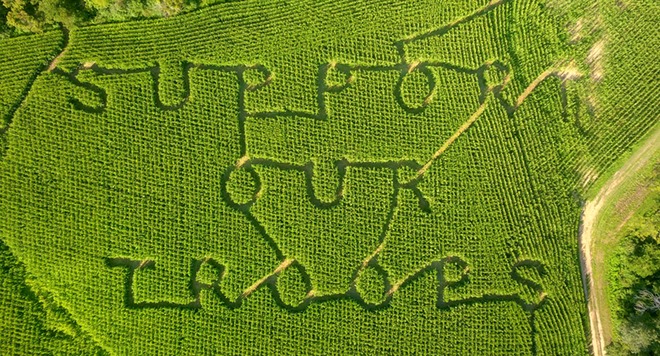Farmers support troops, raise awareness for local groups and celebrate movies in these pieces of field art
By Diego Flammini
Staff Writer
Farms.com
From the side of the road, many corn fields across the United States look similar.
But a bird’s eye view of a corn field can reveal works of art.
Many U.S. farmers plant their fields into corn maze designs and welcome visitors in the fall to participate in the popular agritourism attraction.
Growers use their corn field canvasses to display messages or celebrate something of interest.
Here are a few of the corn mazes making headlines across the U.S. in 2022.
At Richardson Adventure Farm in Spring Grove, Ill., visitors can use their spy skills to escape a corn maze dedicated to 60 years of James Bond.
“We are Bond fans. We love all the films,” said George Richardson, who operates the farm with his family, Good News Network reported.
The maze, which sits on 28 acres and has over 10 miles of trails, includes the five men known for playing Bond – Roger Moore, Timothy Dalton, Sean Connery, Pierce Brosnan and Daniel Craig.
It also features Bond’s Aston Martin and a Bond girl in the middle of the movie franchise’s iconic gun barrel sequence.
In Walnut Cove, N.C., two corn mazes on a farm are dedicated to the men and women of the United States military.
At Armstrong Artisan Farm, visitors can enter try one maze that, when seen from above, says “Support our troops.” Another maze features symbols related to military branches including an anchor, a tank and a ship.

Armstrong Artisan Farm photo
The mazes are a small way to recognize the work members of the military do.
“Our armed forces seldom get the recognition they deserve and this is our way to help raise awareness and honor them,” Jessica Armstrong told WXII.
And in Atkins, Iowa, a farm family is using its corn maze to raise awareness about a local organization.
The corn maze at Bloomsbury Farm recognizes Camp Courageous in Monticello as it celebrates its 50th anniversary.
The organization provides recreational and respite care opportunities for individuals with special needs.
The corn maze includes the organization’s logo and facts about the camp.
Using the corn maze to benefit local community groups is always the plan, said Samantha Petersen, a manager for Bloomsbury Farm.
“Ever since we started the business, my parents had a focus on partnering with nonprofits and organizations bigger than Bloomsbury,” she said, The Gazette reported. “We have a passion for using the design in our corn maze to build awareness for nonprofits.”
The U.S. agritourism has grown in recent years.
Revenue from the agritourism industry has increased from $704 million in 2012 to almost $950 million in 2017, data from the Economic Research Service of the United States department of Agriculture says.
And some research suggests the global agritourism market could be worth $117.37 billion by 2027.